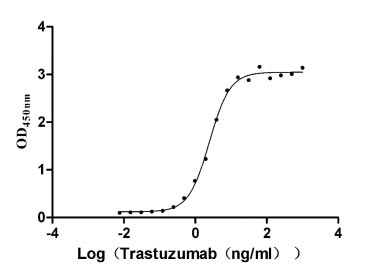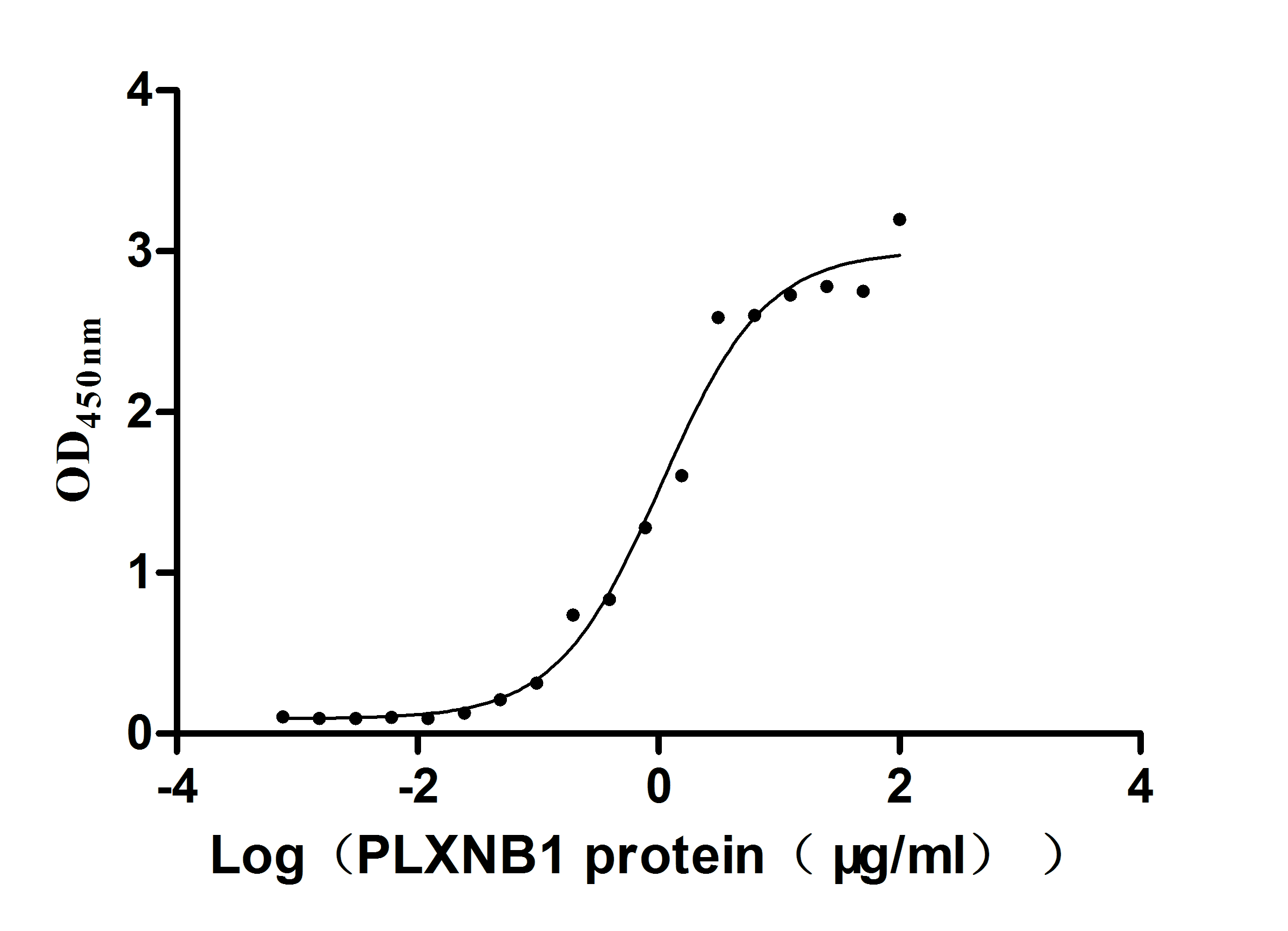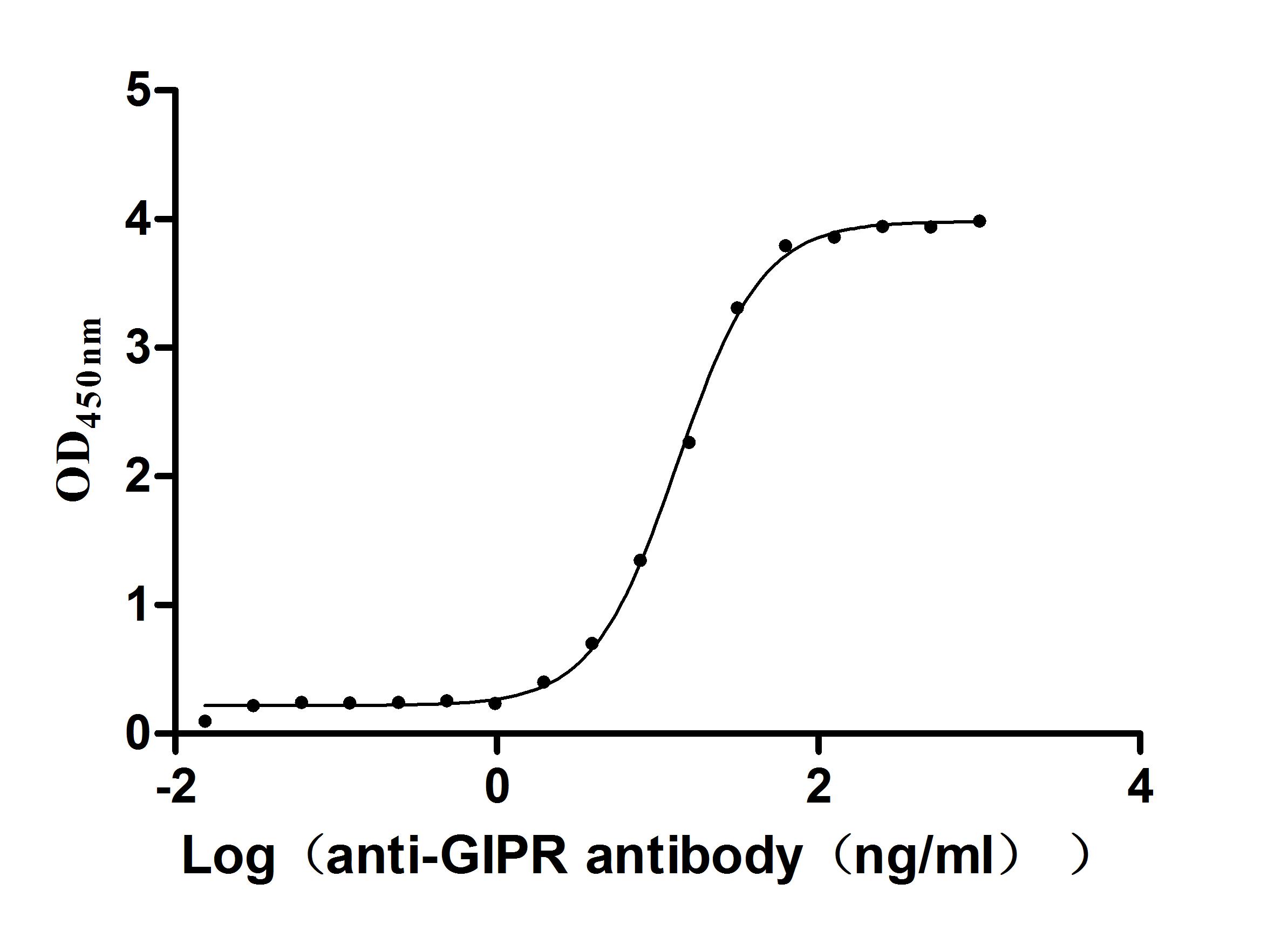Recombinant Human ATP-binding cassette sub-family E member 1 (ABCE1)
-
货号:CSB-YP001076HU
-
规格:
-
来源:Yeast
-
其他:
-
货号:CSB-EP001076HU
-
规格:
-
来源:E.coli
-
其他:
-
货号:CSB-EP001076HU-B
-
规格:
-
来源:E.coli
-
共轭:Avi-tag Biotinylated
E. coli biotin ligase (BirA) is highly specific in covalently attaching biotin to the 15 amino acid AviTag peptide. This recombinant protein was biotinylated in vivo by AviTag-BirA technology, which method is BriA catalyzes amide linkage between the biotin and the specific lysine of the AviTag.
-
其他:
-
货号:CSB-BP001076HU
-
规格:
-
来源:Baculovirus
-
其他:
-
货号:CSB-MP001076HU
-
规格:
-
来源:Mammalian cell
-
其他:
产品详情
-
纯度:>85% (SDS-PAGE)
-
基因名:ABCE1
-
Uniprot No.:
-
别名:2' 5' oligoadenylate binding protein; 2''-5''-oligoadenylate-binding protein; 2'5' oligoadenylate binding protein; ABC 38; ABC38; ABCE 1; ABCE1; ABCE1_HUMAN; ATP binding cassette sub family E (OABP) member 1; ATP binding cassette sub family E member 1; ATP-binding cassette sub-family E member 1; HuHP 68; HuHP68; OABP; Ribonuclease 4 inhibitor; Ribonuclease L (2' 5' oligoisoadenylate synthetase dependent) inhibitor; Ribonuclease L (2'5' oligoisoadenylate synthetase dependent) inhibitor; Ribonuclease L inhibitor; RLI; RNase L inhibitor; RNASEL1; RNASELI; RNS 4I; RNS4I
-
种属:Homo sapiens (Human)
-
蛋白长度:full length protein
-
表达区域:1-599
-
氨基酸序列MADKLTRIAI VNHDKCKPKK CRQECKKSCP VVRMGKLCIE VTPQSKIAWI SETLCIGCGI CIKKCPFGAL SIVNLPSNLE KETTHRYCAN AFKLHRLPIP RPGEVLGLVG TNGIGKSTAL KILAGKQKPN LGKYDDPPDW QEILTYFRGS ELQNYFTKIL EDDLKAIIKP QYVDQIPKAA KGTVGSILDR KDETKTQAIV CQQLDLTHLK ERNVEDLSGG ELQRFACAVV CIQKADIFMF DEPSSYLDVK QRLKAAITIR SLINPDRYII VVEHDLSVLD YLSDFICCLY GVPSAYGVVT MPFSVREGIN IFLDGYVPTE NLRFRDASLV FKVAETANEE EVKKMCMYKY PGMKKKMGEF ELAIVAGEFT DSEIMVMLGE NGTGKTTFIR MLAGRLKPDE GGEVPVLNVS YKPQKISPKS TGSVRQLLHE KIRDAYTHPQ FVTDVMKPLQ IENIIDQEVQ TLSGGELQRV ALALCLGKPA DVYLIDEPSA YLDSEQRLMA ARVVKRFILH AKKTAFVVEH DFIMATYLAD RVIVFDGVPS KNTVANSPQT LLAGMNKFLS QLEITFRRDP NNYRPRINKL NSIKDVEQKK SGNYFFLDD
-
蛋白标签:Tag type will be determined during the manufacturing process.
The tag type will be determined during production process. If you have specified tag type, please tell us and we will develop the specified tag preferentially. -
产品提供形式:Lyophilized powder
Note: We will preferentially ship the format that we have in stock, however, if you have any special requirement for the format, please remark your requirement when placing the order, we will prepare according to your demand. -
复溶:We recommend that this vial be briefly centrifuged prior to opening to bring the contents to the bottom. Please reconstitute protein in deionized sterile water to a concentration of 0.1-1.0 mg/mL.We recommend to add 5-50% of glycerol (final concentration) and aliquot for long-term storage at -20℃/-80℃. Our default final concentration of glycerol is 50%. Customers could use it as reference.
-
储存条件:Store at -20°C/-80°C upon receipt, aliquoting is necessary for mutiple use. Avoid repeated freeze-thaw cycles.
-
保质期:The shelf life is related to many factors, storage state, buffer ingredients, storage temperature and the stability of the protein itself.
Generally, the shelf life of liquid form is 6 months at -20°C/-80°C. The shelf life of lyophilized form is 12 months at -20°C/-80°C. -
货期:Delivery time may differ from different purchasing way or location, please kindly consult your local distributors for specific delivery time.Note: All of our proteins are default shipped with normal blue ice packs, if you request to ship with dry ice, please communicate with us in advance and extra fees will be charged.
-
注意事项:Repeated freezing and thawing is not recommended. Store working aliquots at 4°C for up to one week.
-
Datasheet :Please contact us to get it.
相关产品
靶点详情
-
功能:Cotranslational quality control factor involved in the No-Go Decay (NGD) pathway. Together with PELO and HBS1L, is required for 48S complex formation from 80S ribosomes and dissociation of vacant 80S ribosomes. Together with PELO and HBS1L, recognizes stalled ribosomes and promotes dissociation of elongation complexes assembled on non-stop mRNAs; this triggers endonucleolytic cleavage of the mRNA, a mechanism to release non-functional ribosomes and to degrade damaged mRNAs as part of the No-Go Decay (NGD) pathway. Plays a role in the regulation of mRNA turnover. Plays a role in quality control of translation of mitochondrial outer membrane-localized mRNA. As part of the PINK1-regulated signaling, ubiquitinated by CNOT4 upon mitochondria damage; this modification generates polyubiquitin signals that recruit autophagy receptors to the mitochondrial outer membrane and initiate mitophagy. RNASEL-specific protein inhibitor which antagonizes the binding of 2-5A (5'-phosphorylated 2',5'-linked oligoadenylates) to RNASEL. Negative regulator of the anti-viral effect of the interferon-regulated 2-5A/RNASEL pathway.; (Microbial infection) May act as a chaperone for post-translational events during HIV-1 capsid assembly.; (Microbial infection) Plays a role in the down-regulation of the 2-5A/RNASEL pathway during encephalomyocarditis virus (EMCV) and HIV-1 infections.
-
基因功能参考文献:
- Induction of ribosome rescue factors PELO and HBS1L is required to support protein synthesis when ABCE1 levels fall in platelets, including for hemoglobin production during blood cell development. PMID: 27681415
- ABCE1 is involved in histone biosynthesis and DNA replication and therefore is essential for normal S phase progression. PMID: 26985706
- The present study reported on the effects of ABCE1 overexpression on lung adenocarcinoma cells in vitro, demonstrating its enhancing effect on cell proliferation and invasiveness with simultaneous downregulation of p27 protein expression. PMID: 27314749
- ABCE1 plays an essential role in the progression and metastasis of lung cancers and may represent a valuable therapeutic target for the management of lung tumor PMID: 26733164
- miR-299-3p promotes the sensibility of lung cancer to doxorubicin through suppression of ABCE1, at least partly. Therefore, the disordered decreased of miR-299-3p and resulting ABCE1 up-expression may contribute to chemoresistance of lung cancer PMID: 26617714
- Expression of the ABCE1-silencing gene, transfected by electrotransfer, could inhibit the proliferation, invasion, and migration of thyroid cancer cells. PMID: 26600528
- Downregulation of ABCE1 via siRNA affects the sensitivity of lung cancer cells against chemotherapeutic agents. PMID: 25744244
- ABCE1 is closely associated with cell proliferation, invasion and migration in esophageal cancer and silencing the ABCE1 gene by electroporation can significantly reduce the proliferation, invasion and migration capacity PMID: 25815591
- ABCE1 is able to suppress RNA silencing in Nicotiana benthamiana plants, in mammalian HEK293 cells and in the worm Caenorhabditis elegans. PMID: 25659154
- ABCE1 is closely connected with the pathogenesis and development of oral cancer, which acts through the cellular pathways of 2-5A/RNase L. PMID: 25337191
- ABCE1 is closely connected with the pathogenesis and development of esophageal carcinoma, which act through the cellular pathways of 2-5A/RNase L. PMID: 24551278
- Studies indicate a strong sequence conservation of ABC-type ATPase ABCE1 in eukaryotes and archaea. PMID: 23266104
- ABCE1 protein regulates a broad range of biological functions including viral infection, tumor cell proliferation, and antiapoptosis. (Review) PMID: 23008114
- Pulse chase experiments and immunoelectron microscopy shows that HIV-1 Gag associates transiently with ABCE1 during HIV-1 capsid assembly, including at the plasma membrane where assembly is completed. PMID: 17233757
- HIV-1, HIV-2, SIV mac239, and SIVagm Gag proteins form ABCE1-containing assembly intermediates during immature capsid formation, indicating that Gag proteins of these diverse retroviruses bind to ABCE1 despite the limited homology between these Gags. PMID: 14747530
- For binding of WT HIV-1 Gag to the cellular ATPase ABCE1, which facilitates HIV-1 capsid assembly, the basic residues in the nucleocapsid domain of Gag are required but the cysteine and histidine residues in the nucleocapsid domain are dispensable. PMID: 16275648
- During assembly of an immature HIV-1 capsid, HIV-1 Gag progresses through a pathway of sequential assembly intermediates that contain ABCE1, a cellular ATPase that was found to facilitate capsid formation. PMID: 11780123
- To form HIV-1 capsid assembly intermediates, HIV-1 Gag co-opts a complex found in infected and uninfected cells that contains the cellular ATPase ABCE1 and the RNA helicase DDX6, both of which facilitate HIV-1 capsid assembly. PMID: 22851315
- Report high expression level of ABCE1 mRNA and protein in human lung adenocarcinoma tissues and metastatic lymph nodes, which was also correlated with clinical stages. PMID: 22267055
- Pelota/Hbs1 induced dissociation of elongation complexes from ribosomes and release of peptidyl-tRNA, but only in the presence of ABCE1. PMID: 21448132
- Results suggest that ABCE1 plays an important role in the pathogenesis of human small cell lung cancer cell. PMID: 20372810
- NTP hydrolysis by ABCE1 is stimulated by posttermination complexes and is required for its ribosomal recycling activity. PMID: 20122402
- were able to confirm the excess of rare genetic variation among HIV-1-positive African-American individuals (n=53; Tajima's D=-2.34). These results highlight the potential importance of ABCE1's role in infectious diseases such as HIV-1. PMID: 19657357
- HIV-2 Gag associates with human HP68 in a cell-free system and that Gag proteins of HIV-2, simian immunodeficiency virus SIVmac239, and SIVagm associate with endogenous HP68 in primate cells, as is seen for HIV-1. PMID: 14747530
- overexpression in a permissive cell line had no significant effect on varicella zoster virus replication PMID: 15107989
- ABCE1 and its peptides could be target molecules in specific immunotherapy for HLA-A2(+) colon cancer patients. PMID: 15809757
- The primary role of ABCE-1 in the effect of TULA appears to be the recruitment of TULA to the sites of HIV-1 assembly where TULA interferes with the late steps of the HIV-1 life cycle. PMID: 18006034
- host protein essential for assembly of immature HIV-1 capsids PMID: 11780123
显示更多
收起更多
-
亚细胞定位:Cytoplasm. Mitochondrion. Note=Localized to clusters of virus formation at the plasma membrane.
-
蛋白家族:ABC transporter superfamily, ABCE family
-
数据库链接:
HGNC: 69
OMIM: 601213
KEGG: hsa:6059
STRING: 9606.ENSP00000296577
UniGene: Hs.12013
Most popular with customers
-
Recombinant Human Receptor tyrosine-protein kinase erbB-2 (ERBB2), partial (Active)
Express system: Mammalian cell
Species: Homo sapiens (Human)
-
Recombinant Human Plexin-B1 (PLXNB1), partial (Active)
Express system: Mammalian cell
Species: Homo sapiens (Human)
-
Recombinant Human T-cell surface protein tactile (CD96), partial (Active)
Express system: Mammalian cell
Species: Homo sapiens (Human)
-
Recombinant Rat Intestinal-type alkaline phosphatase 1 (Alpi) (Active)
Express system: Mammalian cell
Species: Rattus norvegicus (Rat)
-
Recombinant Human Microtubule-associated protein tau (MAPT) (Active)
Express system: Mammalian cell
Species: Homo sapiens (Human)
-
Recombinant Macaca fascicularis CD93 molecule (CD93), partial (Active)
Express system: Mammalian cell
Species: Macaca fascicularis (Crab-eating macaque) (Cynomolgus monkey)
-
Recombinant Human Transmembrane 4 L6 family member 1(TM4SF1)-VLPs (Active)
Express system: Mammalian cell
Species: Homo sapiens (Human)
-
Recombinant Macaca Gastric inhibitory polypeptide receptor(GIPR), partial (Active)
Express system: yeast
Species: Macaca fascicularis (Crab-eating macaque) (Cynomolgus monkey)




-AC1.jpg)

-AC1.jpg)













